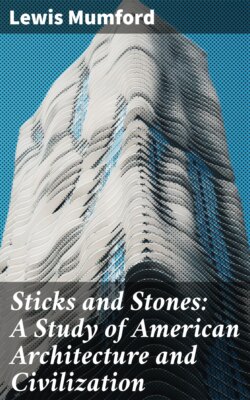Читать книгу Sticks and Stones: A Study of American Architecture and Civilization - Lewis Mumford - Страница 7
На сайте Литреса книга снята с продажи.
IV
ОглавлениеTable of Contents
In essentials, however, both the life and the architecture of the first provincial period are sound. While agriculture is the mainstay of life, and the medieval tradition flourishes, the New England village reaches a pretty fair pitch of worldly perfection; and beneath all the superficial changes that affected it in the next century and a half, its sturdy framework held together remarkably well.
Consider the village itself. In the center is a common, a little to one side will be the meeting-house, perhaps a square barnlike structure, with a hipped roof and a cupola, like that at Hingham; and adjacent or across the way will be the grammar school. Along the roads where the houses are set at regular intervals is a great columnar arcade of elm trees. All these elements are essential to our early provincial architecture, and without them it would be a little bare and forbidding. The trees, above all, are an important part of New England architecture: in summer they absorb the moisture and cool the air, besides giving shade; in the winter their huge boles serve as a partial windbrake; even the humus from their leaves keeps the soil of the lawns in better order. The apple trees that cling to the warmer side of the house are not less essential. Would it be an exaggeration to say that there has never been a more complete and intelligent partnership between the earth and man than existed, for a little while, in the old New England village? In what other part of the world has such a harmonious balance between the natural and the social environment been preserved?
Nowadays we have begun to talk about garden cities, and we realize that the essential elements in a garden-city are the common holding of land by the community, and the coöperative ownership and direction of the community itself. We refer to all these things as if they represented a distinct achievement of modern thought; but the fact of the matter is that the New England village up to the middle of the eighteenth century was a garden-city in every sense that we now apply to that term, and happily its gardens and its harmonious framework have frequently lingered on, even though the economic foundations have long been overthrown.
This is a medieval tradition in American architecture which should be of some use to our architects and city planners; for it is a much more substantial matter than the building of perpendicular churches or Tudor country-houses in painfully archæological adaptations. If we wish to tie up with our colonial tradition we must recover more than the architectural forms: we must recover the interests, the standards, the institutions that gave to the villages and buildings of early times their appropriate shapes. To do much less than this is merely to bring back a fad which might as well be Egyptian as “colonial” for all the sincerity that it exhibits.
